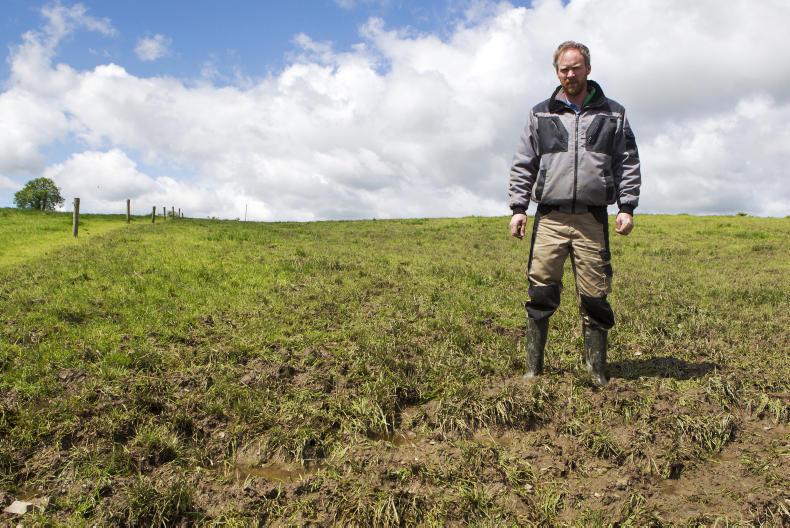Over 3in of rain has fallen in many parts and whatever soil moisture deficits were there in May are well and truly gone now.
All the rain has made grazing difficult and cows are not happy to clean out paddocks, even on dry land. On heavier land, grass is being dirtied, so clean-out is poor as a result.
Grass under stress
All this rain has come at the wrong time. Grass is heading out now, so palatability would drop at this time of year anyway, but the rain, combined with very high growth rate over the past three weeks, has meant there is extra stem in the sward. Grass is getting stressed now too.
All of these factors are leading to a sharp fall in milk supplies. I was talking to a milk lorry driver in Tipperary over the weekend and where he was only visiting three farms to fill the lorry, he is now visiting five farms to get a full load.
So what can one do? The first thing to remember is that all of this rain is temporary and there is a better forecast on the way.
We cannot afford to waste grass
That said, we must manage the present. Many farms are highly stocked, with paddocks out for silage. This means demand for grass is high, so we cannot afford to waste grass. This means going back to 12-hour breaks for the next few days.
Grass dry matters are low and it is amazing how much grass cows are eating to get their fill. This makes allocation difficult. Monitor what area you give them, as it may be necessary to give them more grass when they have their first allocation eaten.
Avoid grazing heavy covers when ground is sticky. Go to lighter covers first and if you really need to, then go back to the heavier covers later this week.
Many paddocks were grazed out poorly over the weekend and late last week. Avoid the temptation to top these now. Topping the regrowths will seriously affect the subsequent regrowths on these paddocks. If topping is to be carried out, do it immediately after the cows leave the field.
Fertilise when weather improves
With a better forecast for later this week, it will be a good opportunity to get some fertiliser out. Grass is becoming pale on many farms. Rapid growth rates and heavy rain have taken their toll on grass and it will need a nutrient top-up soon. Depending on stocking rate and clover levels, I would be thinking close to 30 units/acre should be considered for the month of June.
With drier weather on the way, keep an eye on the forecast and have the contractor teed up to cut and bale the surplus paddocks on the farm. These need to be cut and back growing as soon as possible. These should get slurry or bag potash after cutting.
Read more
Weekly weather: signs of settled conditions returning
Over 3in of rain has fallen in many parts and whatever soil moisture deficits were there in May are well and truly gone now.
All the rain has made grazing difficult and cows are not happy to clean out paddocks, even on dry land. On heavier land, grass is being dirtied, so clean-out is poor as a result.
Grass under stress
All this rain has come at the wrong time. Grass is heading out now, so palatability would drop at this time of year anyway, but the rain, combined with very high growth rate over the past three weeks, has meant there is extra stem in the sward. Grass is getting stressed now too.
All of these factors are leading to a sharp fall in milk supplies. I was talking to a milk lorry driver in Tipperary over the weekend and where he was only visiting three farms to fill the lorry, he is now visiting five farms to get a full load.
So what can one do? The first thing to remember is that all of this rain is temporary and there is a better forecast on the way.
We cannot afford to waste grass
That said, we must manage the present. Many farms are highly stocked, with paddocks out for silage. This means demand for grass is high, so we cannot afford to waste grass. This means going back to 12-hour breaks for the next few days.
Grass dry matters are low and it is amazing how much grass cows are eating to get their fill. This makes allocation difficult. Monitor what area you give them, as it may be necessary to give them more grass when they have their first allocation eaten.
Avoid grazing heavy covers when ground is sticky. Go to lighter covers first and if you really need to, then go back to the heavier covers later this week.
Many paddocks were grazed out poorly over the weekend and late last week. Avoid the temptation to top these now. Topping the regrowths will seriously affect the subsequent regrowths on these paddocks. If topping is to be carried out, do it immediately after the cows leave the field.
Fertilise when weather improves
With a better forecast for later this week, it will be a good opportunity to get some fertiliser out. Grass is becoming pale on many farms. Rapid growth rates and heavy rain have taken their toll on grass and it will need a nutrient top-up soon. Depending on stocking rate and clover levels, I would be thinking close to 30 units/acre should be considered for the month of June.
With drier weather on the way, keep an eye on the forecast and have the contractor teed up to cut and bale the surplus paddocks on the farm. These need to be cut and back growing as soon as possible. These should get slurry or bag potash after cutting.
Read more
Weekly weather: signs of settled conditions returning






 This is a subscriber-only article
This is a subscriber-only article










SHARING OPTIONS: